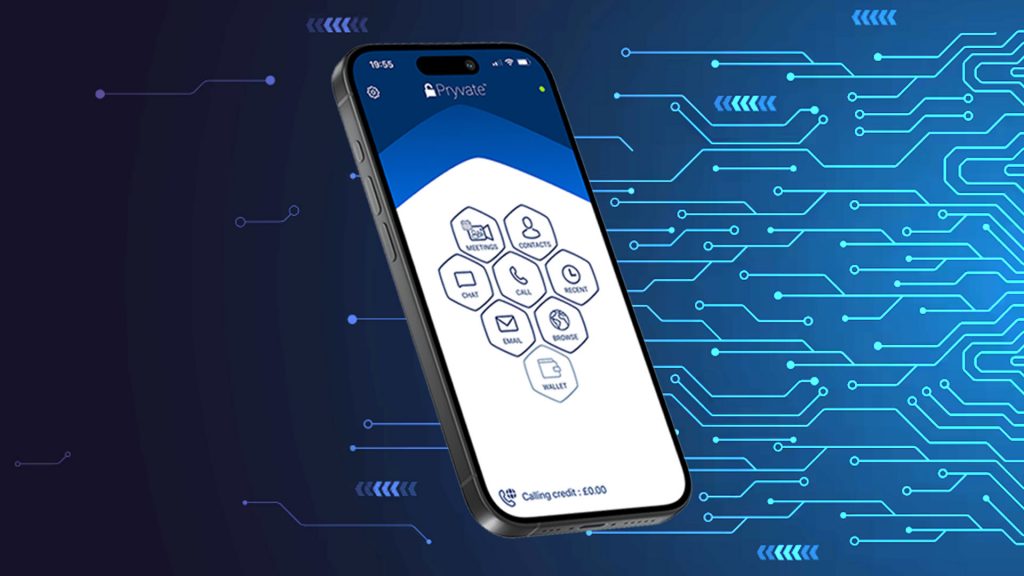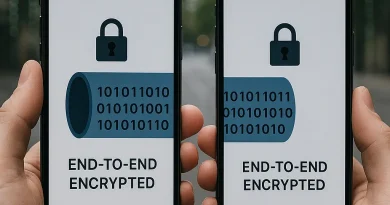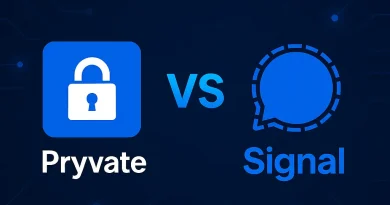Think You’re Safe on WhatsApp? Here’s What Your Metadata Really Reveals
- The metadata you leave behind
- Encryption’s blind spot
- How metadata moves (and why it matters)
- The power of patterns
- Convenience vs control
- What true privacy would look like
Encryption protects your messages – but not the invisible data trails that map your every move.
When WhatsApp introduced end-to-end encryption in 2016, it was hailed as a privacy revolution. “Only you and the person you’re communicating with can read what’s sent,” the company promised.
But what if the danger isn’t in what you say, but in everything else surrounding it?
Welcome to the shadow world of metadata – the who, when, where, and how often behind every message you send. Metadata reveals more about your life than the words you physically type ever could.
And it’s collected constantly, often without you realising it.

The Metadata You Leave Behind
Every message, photo, or call through a mainstream app leaves behind a trail of invisible data points:
- Who you talk to (your contact network)
- When you talk to them (timestamps)
- How often (frequency and duration)
- Where you were (approximate or GPS-based location)
- What device you used (phone model, operating system, connection type)
This metadata doesn’t reveal message content, but it paints a detailed picture of your habits, routines, relationships, and even emotional states.
Think of it like digital handwriting analysis. You might not show anyone your diary, but if someone watched you write every night at 11:43 PM and noted which pages you turned, they’d still learn a lot.
Encryption’s Blind Spot
Apps like WhatsApp and Signal use end-to-end encryption (E2EE), which means your actual messages are scrambled and unreadable to anyone except you and your contact. That’s good – but E2EE doesn’t protect metadata.
Meta (WhatsApp’s parent company) still knows when you’re active, who you’re chatting with, how long you spend in the app, and which numbers are in your contact list. This data feeds into its vast machine-learning systems, building user profiles that power targeted advertising, behavioural insights, and network mapping.
“Metadata absolutely tells you everything about somebody’s life. If you have enough metadata, you don’t really need content.”
Stewart Baker | Former NSA General Counsel
In other words, even if Meta can’t read your words, it’s still painting a scarily detailed picture of you.
How Metadata Moves (and Why It Matters)
Imagine sending a message to a friend across town.
You hit “send.” Within milliseconds, your phone:
- Connects to WhatsApp’s servers – confirming your account and contact details
- Logs the timestamp – recording when and how often you message that contact
- Captures your IP address – which can infer your approximate location
- Syncs contact identifiers – phone numbers, device info, sometimes linked emails
- Communicates through Meta’s infrastructure – where analytics systems quietly note usage trends, delivery times, and network strength.
Even though the text itself is encrypted, all the contextual data around it travels through third-party servers – leaving a breadcrumb trail that can be analysed and monetised.
Visualise it like a glowing web: your messages are locked boxes, but the pathways between them light up every time you communicate. To anyone watching, those glowing lines reveal your relationships, patterns, and digital behaviour.
The Power of Patterns
What can someone do with that metadata?
More than you’d think.
- Social Graphing: By analysing who messages whom and how often, analysts can map entire social networks. Intelligence agencies use this to identify relationships between targets
- Behavioural Prediction: Message frequency and timing reveal routines – when you wake up, go to work, sleep, travel, and more
- Location Correlation: Even without GPS, metadata tied to IP addresses can locate you within a few kilometres – enough to track movements or identify meeting points
- Emotional Insights: Frequent late-night conversations with one person? Sudden stop in communication? Algorithms interpret these as potential relationship changes
In short, metadata doesn’t just show what you do – it shows who you are.
Convenience vs. Control
Why does this happen? Centralised messaging apps rely on servers to route, verify, and store delivery data. Even if that data isn’t sold directly, it fuels performance analytics, product optimisation, and, in the case of Meta, targeted marketing.
In a world increasingly driven by data monetisation, your metadata is gold dust. You might not be paying with money, but you’re paying with information.
And once collected, it’s nearly impossible to erase.

What True Privacy Would Look Like
A truly private messaging system would remove the central points of collection altogether.
That means:
- No servers storing metadata or delivery logs
- No account registration tied to phone numbers or emails
- No contact syncing or background analytics
- Communication that lives only on user devices, never passing through corporate infrastructure
It’s a radically different architecture – one where data protection isn’t a policy, but a design principle.
Why Most Apps Won’t Go That Far
Even privacy-focused messengers like Signal or Telegram still rely on some level of centralised infrastructure. It’s what allows message delivery, contact discovery, and cloud backups.
For large-scale apps, that trade-off is considered “acceptable risk.” But for users who care about digital security, anonymity, and true control, it’s a dealbreaker.
A Future Without Metadata Trails
There’s a new generation of messaging platforms challenging this model – ones built to eliminate metadata altogether.
They use peer-to-peer (P2P) architecture, device-to-device encryption, and temporary message storage, leaving no digital breadcrumbs behind.
That means no logs, no traces, and no servers for hackers, advertisers, or authorities to exploit.
The Pryvate Perspective
Some messengers claim “zero-knowledge,” but still hold metadata logs. Pryvate goes further – operating without centralised servers, contact syncing, or identifiable user data. Messages live only on your devices, not in the cloud.
No phone number. No email. No trace.
In an age where digital identity is currency, true privacy isn’t about what you say – it’s about what your data doesn’t reveal.
Protect your privacy – take back control of your conversations.
Download Pryvate Messenger, the secure, server-free app that keeps your data where it belongs: with you.


